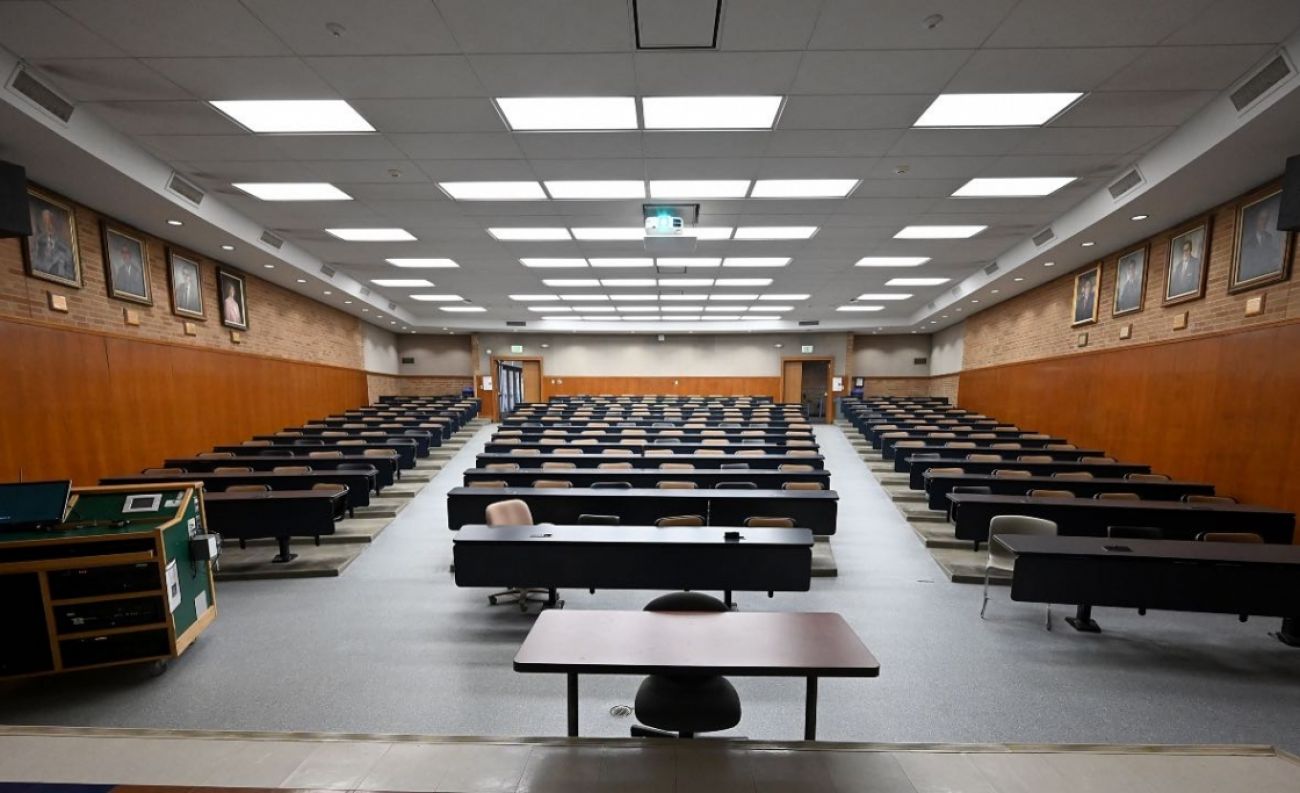As COVID spread, far fewer Michigan high school grads enrolled in college

July 19: Even as COVID wanes, fewer low-income students enroll in Michigan colleges
Michigan high school graduates enrolled in college this past fall at the lowest rate in at least a decade, amid a once-in-a-century pandemic.
Less than 55 percent of 2020 Michigan high school graduates enrolled in college within six months of getting diplomas, a plummet of 5 percentage points in one year, according to data from the Michigan Center for Educational Performance and Information, which tracks state education data.
Most troubling, college-going rates dropped most steeply for student groups that already struggle to reach campus, increasing a gap between low-income students and their more affluent classmates, as well as between white students and their Black, Hispanic and Native American peers.
Related stories:
- Back to school: Michigan free college tuition program attracts 70,000
- Michigan colleges rush to get COVID vaccine in student arms amid surge
- Michigan schools reopened. Then came a spike in COVID outbreaks
- Michigan free college tuition programs spread across the state
- Free college tuition in Michigan: Which schools offer what
- Michigan State plans in-person class, ‘more typical’ fall as COVID ebbs
The economic impact could be severe, both for the teens who don’t enroll in fall 2021 after postponing college during the pandemic, and for a state that is struggling to increase the share of adults with degrees and post-secondary credentials.
“When there are challenges, those with the most equity challenges are going to be hit,” said Ashley Johnson, executive director of Detroit College Access Network, an organization that advocates for college access and affordability for low-income and first-generation students.
“People of color and people of low income are going to be hit the hardest every time.”
Numbers heading the wrong way
Overall, the share of Michigan 2020 high school grads enrolling in college in the six months after earning a diploma was 54.6 percent. A year earlier, 59.8 percent of new high school grads enrolled in college.
Just three years earlier, in the 2016-17 school year, when most of 2020’s seniors were freshmen, 64 percent of the state’s high school graduates enrolled in college within six months.
The 2020 figure is the lowest since accurate data for high-school-to-college rates began being collected by the state in 2009-10.
“We knew it was bad but I didn’t realize it was that bad,” said Maddy Day, board president of the Michigan College Access Network and a consultant at the Annie E. Casey Foundation, a national philanthropy that focuses on improving the futures of vulnerable children, teens and young adults.
“This pandemic has really enlightened racial disparities,” Day told Bridge Michigan. “This pandemic has made it harder for families of color to not just get ahead, but stay even, and they’re falling behind in ways in ways that they won’t be able to keep up.”
According to the data from CEPI:
- In raw numbers, 6,214 fewer high school grads enrolled at a two- or four-year college in 2020 than a year earlier. That’s more than total undergraduate enrollments of Kalamazoo College, Alma College, Olivet College, Albion College and Finlandia University combined.
- Economically disadvantaged student enrollment dropped 6.6 percentage points (from 45.4 percent to 38.8 percent) in 2020, while enrollment for students who are not economically disadvantaged dropped 3.7 percentage points (from 69.1 percent to 65.4 percent).
- While college enrollment dropped across the board, the overall gap between poor and more affluent high school grads expanded during COVID. It now stands at a sobering 26.6 percentage points.
- The share of white high school grads enrolling in college in 2020 dropped 4.8 percentage points (to 58.1 percent), compared to drops of 5.8 percentage points (to 41.9 percent) for Hispanic high school grads and 7.8 percentage points (to 38.9 percent) for Black grads.
- The share of Native American high school graduates going to college in 2020 dropped 6.2 percentage points (to 38.9 percent).
- The college-going rate for Asian Americans in Michigan dropped 3.8 percentage points, to 78.3 percent.
- The decline was steeper at community colleges than four-year schools, dropping 3.3 percentage points at community colleges and 1.9 percentage points at four-year universities and colleges.
- Some school districts saw the share of graduating seniors who enrolled in college drop by more than 20 percentage points. Hamtramck Public School District saw its college enrollment rate drop nearly by half: from 60 percent in 2019 to 35 percent in 2020. Flint Public School District plummeted 23 percentage points.
Statewide college enrollment declines are worrisome because post-secondary degrees generally bring higher incomes, helping college grads and the overall Michigan economy.
Michigan is below the U.S. average in adult degree attainment. The state ranks 34th in the nation in the share of adults with a bachelor’s degree or higher, at 28.1 percent; for the U.S. as a whole, the share of adults with a bachelor’s degree or higher is 30.9 percent.
The median annual wage five years after graduation for a Michigan resident with a high school degree is $24,400, compared to $40,800 for those with an associate’s degree and $52,300 for those with a bachelor’s degree.
Higher incomes also put more money into the state’s economy and raises tax revenue, which pays for government services like roads, parks and police.
Gov. Gretchen Whitmer set a goal of increasing the rate of working-age adults with college degrees or certificates from 49 percent to 60 percent by 2030. The current national average is 51 percent.
The declines in Michigan echoed trends in other states. College enrollment by recent high school grads declined nationally, numbers that also appear tied to the pandemic. Some high school grads put off college because of virtual classes and limits on social gatherings; others chose to take jobs during these uncertain economic times.
Experts don’t know whether students who didn’t enroll in the pandemic will come to campus in the fall of 2021. Historically, high school grads who didn’t immediately enroll in college were less likely to do so later. Those that did enroll later were more likely to enroll in two-year colleges rather than four-year institutions, which, on average, produces more modest lifetime earnings.
It’s tough to get young adults to enroll in college once they start jobs and begin earning paychecks, said DCAN’s Johnson. Getting those 6,000 high school grads from 2020 who would have normally enrolled in college to step onto campus a year later is a challenge both for colleges and the students themselves.
“Many of them are taking entry-level jobs, working to support their families,” Johnson said. “What’s it going to look like in two to three years when they finally decide it’s time to go back to school?
“The (college) pipeline busted,” Johnson said. “How do we run out into the field and collect that water, and make it a smooth transition (to college) when they have bills and children?”
Recruiting new students to campus
In January, Michigan kicked off a tuition-free program for community colleges, called Michigan Reconnect, for most adults age 25 and over who haven’t already earned a degree. Nearly 170,000 have signed up for that program and a similar one for essential workers who worked during the first few months of the pandemic.
High school students who graduated last year, though, won’t qualify for free tuition through Michigan Reconnect for at least six years, when they turn 25.
Some are likely to qualify for free tuition programs that are expanding at community colleges and public universities, depending on their income and where they live.
In Detroit, a program focusing on Hispanic students is working to increase college enrollment and retention with wrap-around services.
“These numbers make the case for holistic” initiatives, said Anita Martinez, director of the Michigan Hispanic Collaborative. “Effective outcomes are connected to high-touch, culturally relevant and two-generation interventions” that work with students and their parents.
Martinez said she believes similar programs could work in other communities, though it would look different for different cultural groups.
Johnson, the Detroit college access advocate, suggested the state drop its minimum age to qualify for the community college tuition-free program Michigan Reconnect from 25 to 18.
“I think it’s an opportunity to do more listening, and align resources where our young people have been hit hardest by the pandemic,” said Day, the board president of Michigan College Access Network.
“If we lose them now, we’re not going to get them back.”
Michigan Education Watch
Michigan Education Watch is made possible by generous financial support from:
Subscribe to Michigan Health Watch
See what new members are saying about why they donated to Bridge Michigan:
- “In order for this information to be accurate and unbiased it must be underwritten by its readers, not by special interests.” - Larry S.
- “Not many other media sources report on the topics Bridge does.” - Susan B.
- “Your journalism is outstanding and rare these days.” - Mark S.
If you want to ensure the future of nonpartisan, nonprofit Michigan journalism, please become a member today. You, too, will be asked why you donated and maybe we'll feature your quote next time!





